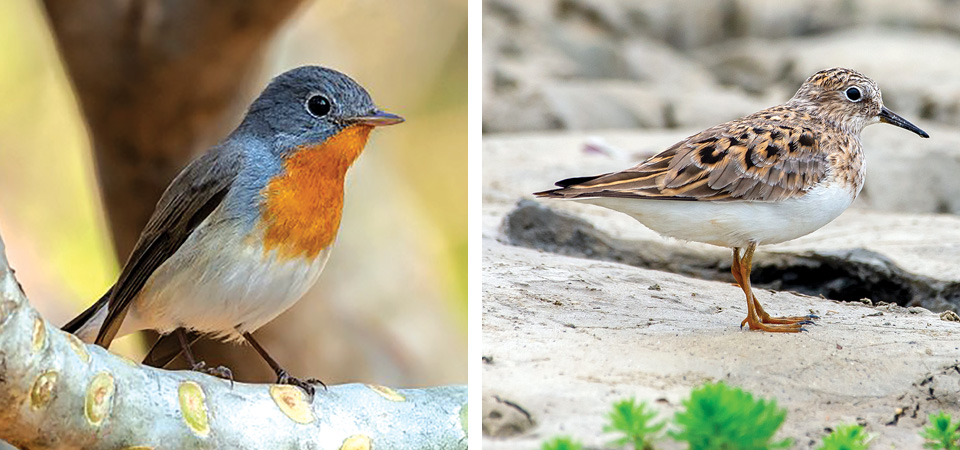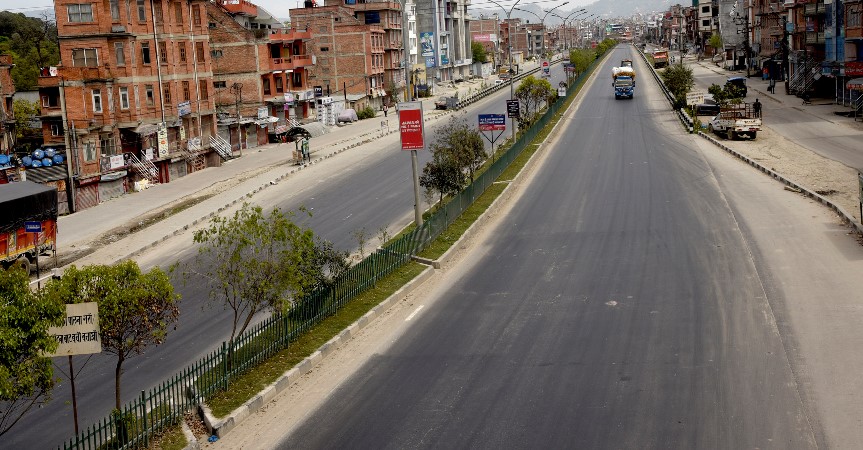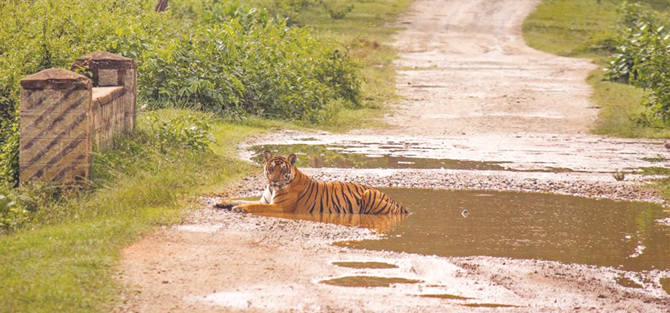A Bird's-eye View On
Migratory Birds In Nepal

Indira Aryal
Birds symbolise a free spirit and inspire many to enjoy the freedom and aim higher in life. After seeing a bird in the sky, a person often wishes to fly like it and roam around places with a free spirit to enjoy life to its fullest.
Though we often see a flock of birds flying high or low in the sky, we often have no idea about the difficult journey many of these birds undertake during their migration to reach our land.
Every winter season, several migratory birds flying from thousands of miles away visit our country, cheer us up and make us feel that winter is a beautiful season. Our wetlands, forests, grassland and river banks come alive with the arrival of hundreds of colourful migratory birds.
Winter Birds
These 'winter birds' migrate here to protect themselves from freezing temperatures in their original habitats. The migration to warmer places in Nepal also provides them with plenty of food, which sends them on a journey of thousands of miles day and night.
The migratory birds have already arrived in our wetlands, rivers, forest and grasslands with the onset of this year's winter. These birds are beautiful and colourful, sizing from small to large. But remember these birds have had a hell of a journey reaching these areas.
Yes, migratory birds have come to Nepal by crossing thousands of miles of distance over the seas and mountains. Migration is one of the biggest events of their life, which is undertaken twice a year between winter and summer. They migrate mainly from their native homes to escape the extreme cold. Our wetlands, forests and grasslands eagerly await to welcome some 150 species of birds every winter season. They come here to feed them and rejoice in warmer weather for almost six months from November to April.
While flying to warmer regions, they experience the coldest of the weather on earth, the strongest of the wind by flying above Mt Everest and face the life-threatening danger from the predators (like eagles and falcons) and even people waiting to kill them. Despite all hardship, they reach our wetlands and forests from the Northern hemisphere to escape harsh weather and spend winters in the warmer climates.
Winter is the largest migratory bird season for Nepal, where almost 150 species of birds arrive from different parts of the planet. Wetland-dependent birds use lakes, ponds, rivers, marshes, reservoirs, and irrigated fields and grasslands of water areas to play and feed.
Some are dependent on wetlands while some stay in forests and grasslands. Weighing from 10 grams to five kilograms, they undertake different patterns of the journey. Some birds take their migratory flight during the night, some during the day and some travel during day and night. One thing that is common to every winter bird is that all of them stay here for nearly six months and go back to their breeding ground. Winter migratory birds do not breed in Nepal.
The majority of Nepal's winter birds come from China, Mongolia, Russia, Europe, Tibetan regions, and other northern countries. These birds spend their winters in wetlands with favourable weather, safe habitat, and winter in feeding areas for almost six months.
The resident birds tend to be less territorial and accept visitors' presence. Upon arrival in Nepal, these visiting birds quickly familiarise themselves with the surroundings and the resident birds. While half of the winter migratory birds are dependent on wetlands, the rest prefer forests and open habitats.
Interesting Species
There are some interesting facts about a few migratory birds that arrive in Nepal during the winter seasons.
Taiga Or Red Throat Flycatcher
The Red Throat Flycatcher or Taiga Flycatcher (Ficedula albicilla) is called ‘Lal Kunthe Arjunak’ in Nepali. Taiga is one of the smallest migrating birds to Nepal. It weighs only 10 grams. They come all the way from the Taiga region of Siberia.
How can a 10-gram bird travel such a long distance through the Himalayas, through the haze and wind? It arrives in Nepal making such a long journey. These birds are found in the lowlands of Terai, including parts of the Kathmandu Valley’s low land. Plenty of Taigas reaches the lowlands of the country. In April, they start their return flight. They do not breed here but breed in northern Eurasia from eastern Russia to Siberia and Mongolia.
As they come from Russia, they have to go through the parts of Mongolia, Tibet and cross the Himalayas. Taiga birds use narrow valleys, low bushes to migrate. They cross an estimated 5000 kilometres to reach Nepal. They can fly during the day and night taking some rest in between. This has been recorded in the IUCN Red List.
Steppe Eagle
Steppe Eagle (Aquila nipalensis), called Gomayu Mahachil in Nepali, is massive in size among the migratory birds. A female can weigh up to five kilograms. The bird is a large bird of prey. It only migrates during the day.
In most cases, these birds have to have thermal or wind direction to undertake their journey. They breed in Mongolia and the Northern part of China, and maybe as far as Southern Siberia. After coming here, they go all the way down to Africa. They follow the passage, low valleys to migrate but also fly above the high mountains.
They have been recorded flying above 7000 metres. They use the bottleneck part while migrating. They are found at certain places in Nepal which use migration paths - Thulakharka in Kaski, and Kaligandaki Valley in Mustang.
A British naturalist, Brian Houghton Hodgson, first discovered this species in Nepal in 1833. He described it as the steppe eagle. Aquila is Latin for "eagle" while Nipalensis means "from Nepal" based on the location where the specimen was first collected presumably when the birds were migrating. The bird is a pirate and carrion eater and takes easily available prey, such as injured birds, stranded fish, rodents, lizards and snakes. Called a friend to farmers, it eats rats and snakes.
Bar-Headed Goose
Bar-headed Goose (Anser indicus) is called Khoya Hans in Nepali. It breeds in China, especially in Qinghai Lake. The bird is a wetland bird that weighs two and a half kilograms. The species of bird is the world’s highest-flying bird while on its regular migration course.
This bird has been sighted at an altitude of 9375 metres high that is above Mt. Everest. Some birds fly higher than this but not regularly. It can make a non-stop flight during the day and night to reach Nepal. They have slightly larger wings than other geese, which is believed to help them fly at high altitudes.
This is the only bird in the world that in due course of migration it takes that height. It is an exceptional bird, which takes that height against strong wind and freezing temperatures. Some 500 to 700 birds are wintering in Narayani River in Chitwan National Park. Occasionally, they are found in the wetlands of Kathmandu Valley.
Demoiselle Crane
Demoiselle Crane (Grus virgo) Called Karangkurung in Nepali. They breed in Mongolia, Russia and China. There is a cultural significance of this bird in Nepal. However, they are migrating here in a few numbers. They pass through Nepal in big numbers during winter and reach Rajasthan and other parts of India. They sometimes use valleys everywhere –the Arun Valley, Karnali Valley and Gandaki Valley, even through Kathmandu sometimes.
It doesn’t stay in Nepal in large numbers but if the weather is bad they come down looking for the plain area. They migrate during the day. The Kaligandaki Valley is a famous corridor for its migration. When they are migrating, the golden eagle is looking to hunt them. A small number of these birds may winter in the low land in Nepal. They winter in fields and shallow water or farmland. They live in a variety of different environments, including desert areas and numerous types of grasslands (flooded, mountain, temperate and tropical grassland) which are often within a few hundred metres of streams or lakes.
However, when nesting, they prefer patchy areas of vegetation, which are tall enough to conceal them and their nests, yet short enough to allow them to look out for predators whilst incubating their eggs.
Temminck’s Stint
Called Jalrang in Nepali, Temminck’s Stint (Calidris temminckii) breeds in several areas including Europe and weighs around 30 to 40 grams. It is a wetland bird and again it has to come through mountains and passages. It stops in a few places but it can also make a non-stop flight. Small Taigas have to survive gutsy winds, cold and predators such as eagles and falcons during their migration to Nepal. The breeding habitat is bogs and marshes in the Taiga of Arctic northern Europe and Asia.
Reserve Fat
Migratory birds who take non-stop journey to reach their destination reserve fat before they start their journey. They will start their journey accumulating a lot of fat in their body. The excessive foods they eat convert into fat which burns during migration to give them the required energy. When they reach their destinations, they lose all the body fat and many of them do not have energy left. During that time, they are highly vulnerable and might be killed by predators and hunters.
All the migratory birds follow different strategies to keep themselves safe from dangers. Some have strategies to change their feathers, some have strategies to change flight paths or fly during nights while some fly during the daytime. Most of these birds fly during the night to avoid predators.
Among the various birds that come to Nepal during winter, times are Mallards, Ruddy Shelducks, Gadwalls, Eurasian Teals, Greenshanks, Thrushs, Fly Catchers, Booted Eagles and a few other birds. Grey-headed Lapwing, Common Teals and the Eurasian pigeon duck species can be sighted in Taudaha and Bagmati corridors along Chobhar up to mid-winter season.
Risks
Wetland encroachment, leakage of chemical fertilisers and pesticides used in the surrounding fields, disposal of sewage and festival supplies, contamination of outdoor and mica species, soil erosion and accumulation of rocks, sand and silt along with erosion and uncontrolled excavation of riverine materials in recent days have posed greater threats to these birds. The construction of physical infrastructure and crowds around the habitat area is also threatening the conservation of such special guests.
Jagdishpur reservoir in Kapilvastu, Ghodaghodi Lake in Kailali, Koshi Tappu Wildlife Reserve, Karnali, Narayani and Koshi River areas, among others, are now flocked by migratory birds. The number of birds remains stable in Nepal; however, there has been ups and downs in the number in different wetlands every year.
In the past few years, the number of migratory birds in the wetlands around the Kathmandu Valley has declined due to the rapid construction of concrete structures and other development works.
Nepal is home to about nine per cent of the total bird species found worldwide. So far, 889 species of birds have been recorded in the country, out of which 42 species are globally endangered. (Based on talks with Dr Hem Sagar Baral, a noted ornithologist from Nepal)
(The author is a journalist at this daily and writes on wildlife and conservation)
Recent News

Do not make expressions casting dout on election: EC
14 Apr, 2022
CM Bhatta says may New Year 2079 BS inspire positive thinking
14 Apr, 2022
Three new cases, 44 recoveries in 24 hours
14 Apr, 2022
689 climbers of 84 teams so far acquire permits for climbing various peaks this spring season
14 Apr, 2022
How the rising cost of living crisis is impacting Nepal
14 Apr, 2022
US military confirms an interstellar meteor collided with Earth
14 Apr, 2022
Valneva Covid vaccine approved for use in UK
14 Apr, 2022
Chair Prachanda highlights need of unity among Maoist, Communist forces
14 Apr, 2022
Ranbir Kapoor and Alia Bhatt: Bollywood toasts star couple on wedding
14 Apr, 2022
President Bhandari confers decorations (Photo Feature)
14 Apr, 2022









